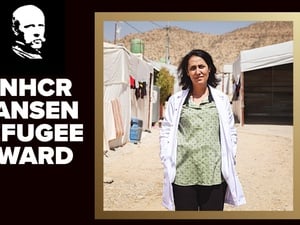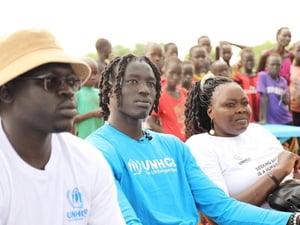Tide of violence threatens Colombian river communities
Tide of violence threatens Colombian river communities

The indigenous villagers of Unión Balsamito, a village on the San Juan River, in Colombia's Chocó province, are frequently threatened by irregular armed groups.
BUENAVENTURA, Colombia, December 9 (UNHCR) - "Vamos, vamos," the captain shouts as he starts the boat's twin outboard motors. The expedition to visit Afro-Colombian and indigenous communities along the San Juan River in the Colombian department of Chocó is already late setting off. Yet, when a man comes running down the pier waving a letter, the captain turns back to receive it from him. The boat may be the last "postal service" for several days going up the delta to villages and settlements without phone lines and often without electricity as well.
It is raining heavily as the boat heads out for the Pacific Ocean. On board are NGO representatives, journalists and UNHCR staff, sheltering as best as they can under raincoats, tarpaulins, hats, caps and jackets - all to no avail: the sea is rough, and water is pouring in from all sides. At first everyone seems to enjoy the challenge, but after the first hour of this back-breaking journey, the laughter has stopped. The rain, on the other hand, continues relentlessly.
Chocó is one of the world's most humid regions and home to indigenous and Afro-Caribbean communities who for centuries have lived on the shores of its many rivers. In recent years, they have become the targets of Colombia's irregular armed groups, who for decades have been locked in armed combat with each other as well as against the regular army.
In their fight for territory, the irregular groups terrorize the local population, forcing thousands of people every year to flee their homes. At times, they impose blockades on the rivers - often for weeks on end - to control all movement in and out of the area, using the opportunity to confiscate salt, rice, oil and even medicine from the villagers on their way back from the local town market.
The three-day boat expedition was organized by a local church to raise awareness of the humanitarian tragedy the local communities are facing. UNHCR agreed to provide logistical support for an initiative that also aimed to strengthen the relationship between the villagers and humanitarian institutions.
The first stop on the journey is Unión Balsamito, a small settlement that is home to one of 30 indigenous communities living along the San Juan River. Just a few days ago, a young man died of snakebite here, because there was no serum available. An avoidable death in many other places - but there are no pharmacies, let alone hospitals, near Unión Balsamito.
"We welcome you in our land," said one of the Wounaan people's leaders as he greeted the expedition. "It is very important to us that you come to visit us. When people come to see us, we can show something very important: that we are here."
The tragedy that is befalling Chocó's indigenous communities remains largely invisible. The outside world knows little of what happens in these remote communities, many of which can only be reached by boat. All over Colombia, crimes and human rights abuses against indigenous people frequently go unreported, and remain unpunished. According to the National Indigenous Organization of Colombia (ONIC), more than 1,600 indigenous people were murdered in the past twenty years - 60 percent of them during the last five years.
ONIC's statistics also show that, since the start of this year, more than 19,000 indigenous men, women and children have been forced to leave their homes to escape the conflict. There are over two million internally displaced persons in Colombia, and while forced displacement is always a terrible experience, it is especially catastrophic for indigenous people: their culture is closely linked to the land, and displacement often leads to the total collapse of traditional authority and cultural patterns.
Despite the enormous pressure put upon them, indigenous and Afro-Caribbean communities in Chocó are doing everything they can to remain in their ancestral homes. Surrounded by thick rainforests and muddy waters, Docordó, on the other side of the river from Unión Balsamito, is typical of many other villages in Chocó. Its houses and huts are built on piles that allow floodwaters to flow underneath; there are no cars in its one unpaved street; dozens of children are milling around.
The people here are largely dependent on fishing and hunting for their survival, a way of life bound to the river and the forest that is threatened by the presence of irregular armed groups in the area. "We do not dare to chase animals at night any more," one villager says. "It is as if we were strangers in our own homes."
Caught up between warring irregular armed groups, the population lives in fear of violence, forced recruitment and retaliatory killings. Community leaders who try to resist the armed groups are especially targeted.
"'Either you leave the river, or you'll leave it in a box' - that's the way they put their threats," a black community leader in Docordó says. "Several community leaders have been killed already."
He too stresses the importance of receiving visits from the outside world. "From the State," he complains, "we do not receive any support whatsoever. It is very important that people come so that we are no longer totally invisible."
An old lady in her seventies who has been observing the visitors for some time from a distance finally approaches them as they are about to step into their boats again. "We are so glad you are here," she says with a warm smile. "Several weeks ago they told us you would be coming. And now you are here, we are so glad - you cannot imagine."
By Roland Schönbauer in Buenaventura, Colombia









